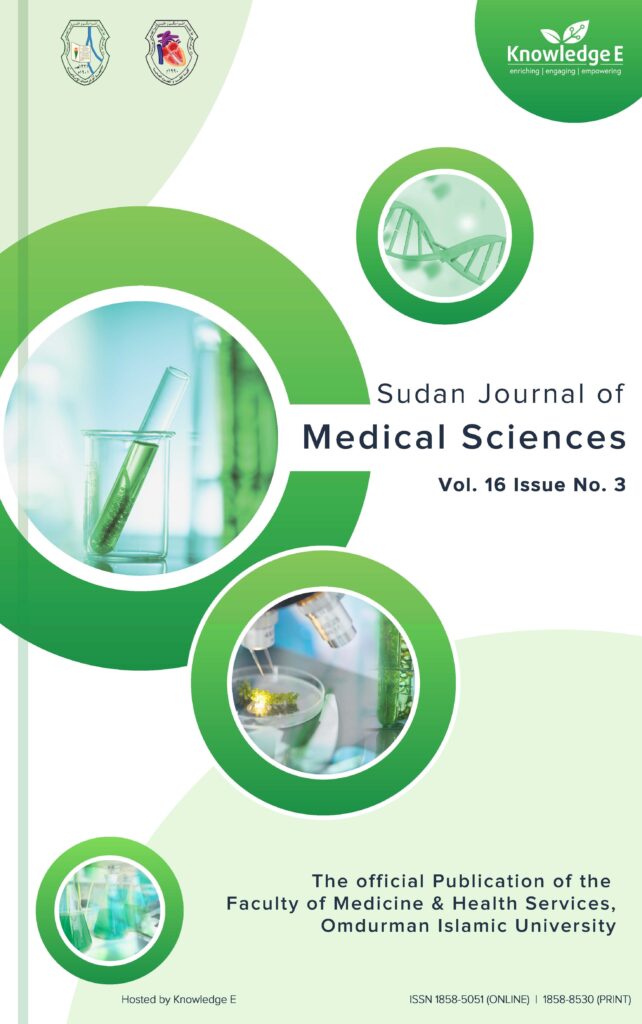
Sudan Journal of Medical Sciences
ISSN: 1858-5051
High-impact research on the latest developments in medicine and healthcare across MENA and Africa
Knowledge and Awareness of Diabetic Retinopathy among Diabetic Sudanese Patients, Khartoum State, Sudan, 2018
Published date:Dec 31 2021
Journal Title: Sudan Journal of Medical Sciences
Issue title: Sudan JMS: Volume 16 (2021), Issue No. 4
Pages:476 - 488
Authors:
Abstract:
Background: The level of awareness of diabetic retinopathy is considered an important factor for early diagnosis and management of diabetic retinopathy. This study aimed to assess the level of awareness of diabetic retinopathy among patients with diabetes mellitus in Khartoum, Sudan.
Methods: This cross-sectional study was conducted among diabetic patients attending Zeenam and Abdullah Khalil Diabetic Centers between June and September 2018. A convenience sample of diabetic patients was used. Information on the sociodemographic characteristics of the patients, patients’ knowledge, compliance with available treatments, and routine eye examinations was collected using a semi-structured questionnaire. Patients were also asked about the barriers that may interfere with a regular eye examination.
Results: A total of 200 patients were enrolled and 94 (47%) of them were female; 13% of the respondents were diagnosed with diabetic retinopathy, 31.5% were hypertensive, and 13.5% had hyperlipidemia. Additionally, 88.5% of the patients were aware that DM can affect their eyes and 87% had never been diagnosed with diabetic retinopathy. Although around 83% thought that diabetic retinopathy could lead to blindness, only 35.5% of them had undergone fundus examination by ophthalmologists. Moreover, 39% of the participants had irregular diabetes follow-up and 43% monthly follow-up. Only 31% went for regular eye check-up; however, their compliance with routine retinal assessment was poor, with a total of 72.5% of participants assuming that they have good vision and need not get their eyes checked up regularly. The chief factor that was related to increased awareness of diabetic retinopathy in the study was the level of education.
Conclusion: Although a large proportion of diabetic patients in Khartoum are aware that diabetes mellitus can affect their eyes, regular retinal assessment of patients was poor, thus hindering early diagnosis and management.
Keywords: awareness, diabetic retinopathy, diabetes mellitus
References:
[1] International Diabetes Federation. (2019). IDF Diabetes Atlas (9th ed.). Brussels, Belgium: International Diabetes Federation. Retrieved from: http://www.diabetesatlas.org (accessed 2020 April 11).
[2] Sepúlveda, J. and Murray, C. (2014) Diabetic retinopathy (DR) is the commonest cause of blindness in productive aged of individuals in developed countries. vol. 345, no. 6202, pp. 1275–1278.
[3] Duh, E. J., Sun, J. K., and Stitt, A. W. (2017). Diabetic retinopathy: current understanding, mechanisms, and treatment strategies: JCI Insight, vol. 2, no. 14, p. e93751.
[4] Memon, M. S., Shaikh, S. A., Shaikh, A. R., et al. (2015) An assessment of knowledge, attitude and practices (KAP) towards diabetes and diabetic retinopathy in a suburban town of Karachi. Pakistan Journal of Medical Sciences, vol. 31, no. 1, pp. 183–188.
[5] World Health Organization. (2012). State the world’s sight: VISION 2020: the right to sight: 1999–2005. Geneva: WHO. Retrieved from: https://apps.who.int/iris/bitstream/handle/10665/43300/9241593458_eng.pdf?sequence=1&isAllowed=y
[6] Hipwell, A. E., Sturt, J., Lindenmeyer, A., et al. (2014)Attitudes, access and anguish: a qualitative interview study of staff and patients' experiences of diabetic retinopathy screening. BMJ Open, vol. 4, no. 12, p. e005498.
[7] Palmer, J. J., Chinanayi, F., Gilbert, A., et al. (2014) Trends and implications for achieving VISION 2020 human resources for eye health targets in 16 countries of sub-Saharan Africa by the year 2020. Human Resources for Health, vol. 12, article 45.
[8] Magliah, S. F., Bardisi, W., Al Attah, M., et al. (2018). The prevalence and risk factors of diabetic retinopathy in selected primary care centers during the 3-year screening intervals Journal of Family Medicine and Primary Care, vol. 7, no. 5, pp. 975–981.
[9] Khandekar, R., Al Harby, S., Al Harthy, H., et al. (2010). Knowledge, attitude and practice regarding eye complications and care among Omani persons with diabetes - a cross-sectional study. Oman Journal of Ophthalmology, vol. 3, no. 2, pp. 60–65.
[10] Al Zarea, B. K. (2016). Knowledge, attitude and practice of diabetic retinopathy amongst the diabetic patients of AlJouf and Hail Province of Saudi Arabia. Journal of Clinical and Diagnostic Research, vol. 10, no. 5, pp. NC05–NC08.
[11] Bakkar, M. M., Haddad, M. F., and Gammoh, Y. S. (2017). Awareness of diabetic retinopathy among patients with type 2 diabetes mellitus in Jordan. Diabetes, Metabolic Syndrome and Obesity, vol. 10, pp. 435–441.
[12] Phillipsa, K. C., Mashigeb, K. P., and Clarke-Farrc, P. C. (2011). Knowledge of diabetes mellitus in privately funded diabetic patients attending a rural optometric practice in Malmesbury, South Africa. The South African Optometrist, vol. 71, no. 2, pp. 70–77.
[13] Mwangi, M. W., Githinji, G. G., and Wanjiru, F. (2011). Knowledge and awareness of diabetic retinopathy amongst diabetic patients in Kenyatta National Hospital, Kenya. International Journal of Humanities and Social Science, vol. 1, no. 21, pp. 140–146.
[14] Bodunde, O. T., Odusan, O., Ogunsemi, O. O., et al. (2014). Awareness of ocular complications of diabetes among diabetic patients in a tertiary hospital in western Nigeria. IOSR Journal of Dental and Medical Sciences, vol. 13, no. 6, pp. 09–12.
[15] Srinivasan, N. K., John, D., Rebekah, G., et al. (2017). Diabetes and diabetic retinopathy: knowledge, attitude, practice (KAP) among diabetic patients in a tertiary eye care centre. Journal of Clinical and Diagnostic Research, vol. 11, no. 7, pp. NC01–NC07.